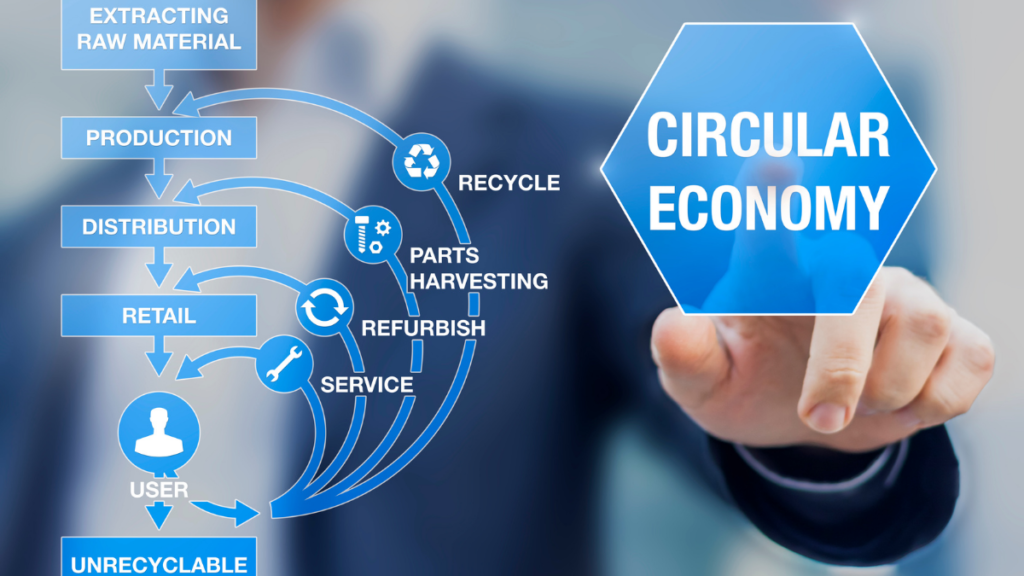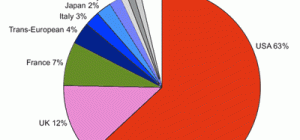 As we face global environmental challenges, it is essential to rethink our production and consumption patterns. The circular economy offers a sustainable alternative to the traditional linear model, promoting resource efficiency and waste reduction. We will analyze the concept, benefits, drawbacks, and challenges of the circular economy, providing insights from scientific research and expert opinions. We will also explore the potential of this innovative approach to help us transition towards a zero-waste society.
As we face global environmental challenges, it is essential to rethink our production and consumption patterns. The circular economy offers a sustainable alternative to the traditional linear model, promoting resource efficiency and waste reduction. We will analyze the concept, benefits, drawbacks, and challenges of the circular economy, providing insights from scientific research and expert opinions. We will also explore the potential of this innovative approach to help us transition towards a zero-waste society.
The Concept of Circular Economy
The circular economy is an economic model that aims to decouple economic growth from the consumption of finite resources by adopting a closed-loop system (Stahel, 2016). This approach involves designing products and processes that minimize waste, promote reuse, and extend the lifecycle of resources, ultimately contributing to a more sustainable and efficient economy. The Ellen MacArthur Foundation (2013) identifies three core principles of the circular economy:
1) Preserve and enhance natural capital;
2) Optimize resource yields;
3) Foster system effectiveness.
Benefits of the Circular Economy
Implementing a circular economy has several advantages, both for the environment and the economy. By reducing waste generation and resource extraction, the circular economy can help mitigate climate change, reduce pollution, and protect biodiversity (Ghisellini et al., 2016). Furthermore, it can promote innovation, create new jobs, and boost economic growth (Lieder & Rashid, 2016). For instance, the European Commission (2020) estimates that a fully functioning circular economy in the European Union could generate a 1% increase in GDP and create 700,000 new jobs by 2030.
1. Resource Efficiency: The circular economy promotes the efficient use of resources by minimizing waste, reducing raw material consumption, and maximizing the life cycle of products.
2. Waste Reduction: By encouraging reuse, recycling, and remanufacturing, the circular economy significantly reduces the amount of waste generated and sent to landfills.
3. Environmental Protection: The reduction of waste and resource consumption leads to a decrease in pollution, greenhouse gas emissions, and other environmental impacts associated with traditional linear economies.
4. Economic Growth: The circular economy has the potential to create new markets, businesses, and jobs while reducing dependence on scarce resources.
5. Cost Savings: Businesses can save money through the more efficient use of resources, reduced waste disposal costs, and lower production costs due to recycling and remanufacturing.
6. Innovation: The circular economy encourages businesses to develop new technologies and processes to optimize resource use, extend product life, and create sustainable products and services.
7. Enhanced Competitiveness: Companies that adopt circular economy principles are better positioned to succeed in a resource-constrained world, as they can offer more sustainable products and services that meet growing demand.
8. Energy Savings: The circular economy can lead to significant energy savings through improved resource efficiency, recycling, and reusing materials.
9. Job Creation: The circular economy has the potential to create new jobs in sectors such as recycling, remanufacturing, and repair services.
10. Reduced Resource Dependency: By promoting the reuse and recycling of materials, the circular economy helps to reduce reliance on finite natural resources and imported raw materials.
11. Social Benefits: The circular economy can help improve living conditions and reduce poverty by creating new economic opportunities and providing access to affordable, sustainable products and services.
12. Sustainable Development: The circular economy supports the United Nations Sustainable Development Goals by promoting responsible consumption and production, ensuring sustainable economic growth, and protecting the environment.
13. Resilience: The circular economy helps to build more resilient societies by reducing the vulnerability of economies to resource price shocks and supply disruptions.
14. Community Empowerment: The circular economy can empower local communities by creating new business opportunities, fostering local innovation, and encouraging collaboration and knowledge sharing.
15. Long-term Sustainability: By shifting to a circular economy, societies can transition towards a more sustainable future that growth, environmental protection, and social well-being.
Challenges in Transitioning to a Circular Economy
Despite its apparent benefits, transitioning to a circular economy entails overcoming various challenges. One of the main obstacles is a mindset to embrace this new economic model (Murray et al., 2017). Businesses, consumers, and policymakers must prioritize long-term value creation and sustainability over short-term profits and growth. Furthermore, a lack of knowledge, technical expertise, and financial resources can hinder the adoption of circular practices (Ranta et al., 2018). Additionally, existing regulations and market structures often favor linear production models, complicating the transition towards a circular economy (Kirchherr et al., 2017).
1. High initial costs: Transitioning to a circular economy often requires significant financial investments to redesign products, processes, and business models.
2. Resistance to change: Many businesses and individuals may be resistant to adopting new practices, preferring to stick to familiar linear models.
3. Lack of infrastructure: Developing the necessary infrastructure to support a circular economy, such as recycling facilities and efficient transportation systems, can be challenging and costly.
4. Limited availability of skilled workers: A circular economy often requires specialized skills and knowledge. There may be a shortage of skilled workers available to support the transition.
5. Regulatory barriers: Existing regulations and policies may not support the circular economy, creating barriers for businesses seeking to implement circular practices.
6. Complex global supply chains: Circular economy practices may be difficult to implement in complicated global supply chains with numerous suppliers, manufacturers, and customers.
7. Technological limitations: Some recycling and reuse technologies are not yet advanced enough to support a fully circular economy.
8. Consumer habits: Many consumers are accustomed to a disposable, throwaway culture and may be unwilling to change their habits to support a circular economy.
9. Limited incentives: There may be a lack of financial incentives or other benefits for businesses and individuals to participate in a circular economy.
10. Loss of economies of scale: The circular economy often involves smaller-scale, localized production, which can result in decreased efficiency and increased costs compared to large-scale, centralized production.
11. Market fluctuations: The circular economy relies on stable markets for recycled materials, and fluctuations in demand and prices can create challenges.
12. Difficulties in measuring impact: It can be difficult to quantify the environmental and economic benefits of the circular economy, making it challenging to assess its overall impact and effectiveness.
13. Intellectual property concerns: Sharing information and collaborating with other businesses is often essential in a circular economy, but this can raise concerns about protecting intellectual property and trade secrets.
14. Short-term focus: Businesses and individuals may prioritize short-term financial gains over the long-term benefits of a circular economy, making it difficult to create lasting change.
15. Uneven global adoption: The success of a circular economy depends on widespread adoption, but disparities in technology, resources, and infrastructure may hinder progress in some regions.
Circular Economy – 10 Best Practices
Various industries have started to adopt circular economy principles, providing valuable examples of how this model can be applied in practice. In the construction sector, modular and prefabricated buildings allow for easy disassembly, reuse, and recycling of materials (Pomponi & Moncaster, 2017). In the electronics industry, companies like Fairphone have designed smartphones with replaceable components, extending their lifespan and reducing electronic waste (Huisman et al., 2017). Moreover, in the fashion sector, initiatives like clothing rental services and upcycling programs help reduce textile waste and promote sustainable consumption (Bocken et al., 2017).
1. Product-as-a-Service: Companies offer products as a service, rather than selling them outright. This means customers pay to use the product for a specific period rather than owning it. This model encourages companies to create durable, high-quality products that can be easily maintained and upgraded, extending their lifecycle.
2. Repair and Maintenance Services: Companies provide repair and maintenance services for their products, ensuring that they last longer and reducing waste. This practice encourages the reuse and refurbishment of products, reducing the need for new materials and energy to produce replacements.
3. Recycling and Upcycling: Companies invest in recycling infrastructure and processes to turn waste materials into new products. Upcycling involves repurposing waste materials into higher-value products, further reducing waste and resource consumption.
4. Cradle-to-Cradle Design: This emphasizes the creation of products that can be easily disassembled and recycled at the end of their life. This helps reduce waste and allows for valuable materials to be recovered and reused in new products.
5. Industrial Symbiosis: Companies collaborate to use the waste materials generated by one company as raw materials for another, creating a closed-loop system where waste is minimized and resources are shared.
6. Remanufacturing: This practice involves taking used products, disassembling them, and rebuilding them to meet or exceed the original specifications. Remanufacturing extends the life of a product and reduces the need for new materials and energy.
7. Sustainable Procurement: Companies prioritize purchasing products and services that have a lower environmental impact and contribute to a circular economy. This can include sourcing materials that are recycled, reusable, or biodegradable.
8. Waste-to-Energy: Waste materials are converted into energy through processes such as anaerobic digestion or incineration. This energy can then be used to power other processes or be fed back into the grid, reducing reliance on fossil fuels.
9. Sharing Economy: Platforms and businesses facilitate the sharing of products, services, and resources, reducing the need for individuals to purchase and own items. This helps minimize waste and promote the efficient use of resources.
10. Zero Waste Manufacturing: Companies implement processes and technologies
Conclusion
The circular economy offers a viable path towards a zero-waste society, where resources are used efficiently, and waste is minimized. By embracing this innovative model, we can mitigate environmental challenges, foster sustainable economic growth, and improve our overall quality of life. However, the transition to a circular economy requires a collective effort from businesses, consumers, and policymakers to overcome current barriers and promote widespread adoption. As we continue to explore the potential of the circular economy, it is crucial that we invest in research, education, and collaboration to ensure a sustainable future for generations to come.
References
Bocken, N. M. P., de Pauw, I., Bakker, C., & van der Grinten, B. (2016). Product design and business model strategies for a circular economy. Journal of Industrial and Production Engineering, 33(5), 308-320.
Ellen MacArthur Foundation. (2013). Towards the circular economy. Retrieved from https://www.ellenmacarthurfoundation.org/assets/downloads/publications/Ellen-MacArthur-Foundation-Towards-the-Circular-Economy-vol.1.pdf
European Commission. (2020). The European Green Deal. Retrieved from https://ec.europa.eu/info/strategy/priorities-2019-2024/european-green-deal_en
Geissdoerfer, M., Savaget, P., Bocken, N. M., & Hultink, E. J. (2017). The Circular Economy – A new sustainability paradigm?. Journal of Cleaner Production, 143, 757-768.
Ghisellini, P., Cialani, C., & Ulgiati, S. (2016). A review on circular economy: The expected transition to a balanced interplay of environmental and economic systems. Journal of Cleaner Production, 114, 11-32.
Huisman, J., Baldé, C. P., Magalini, F., & Kuehr, R. (2017). E-waste monitor. United Nations University. Retrieved from https://collections.unu.edu/eserv/UNU:6341/Global-E-waste_Monitor_2017__electronic_single_pages_.pdf
Kirchherr, J., Reike, D., & Hekkert, M. (2017). Conceptualizing the circular economy: An analysis of 114 definitions. Resources, Conservation and Recycling, 127, 221-232.
Lieder, M., & Rashid, A. (2016). Towards circular economy implementation: A comprehensive review in context of manufacturing industry. Journal of Cleaner Production, 115, 36-51.
Murray, A., Skene, K., & Haynes, K. (2017). The circular economy: An interdisciplinary exploration of the concept and application in a global context. Journal of Business Ethics, 140(3), 369-380.
Pomponi, F., & Moncaster, A. (2017). Circular economy for the built environment: A research framework. Journal of Cleaner Production, 143, 710-718.
Ranta, V., Aarikka-Stenroos, L., Ritala, P., & Mäkinen, S. J. (2018). Exploring institutional drivers and barriers of the circular economy: A cross-regional comparison of China, the US, and Europe. Resources, Conservation and Recycling, 135, 70-82.
Stahel, W. R. (2016). The circular economy. Nature, 531(7595), 435-438.








